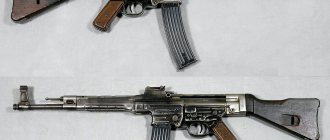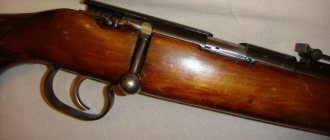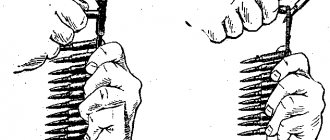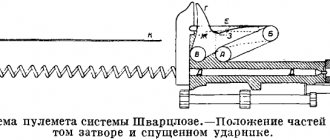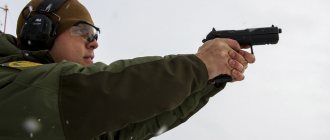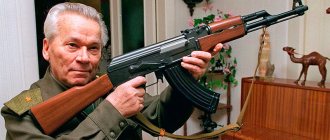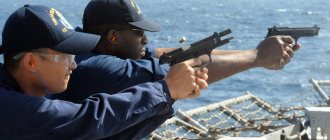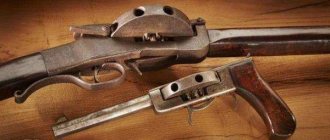LiveInternetLiveInternet
Quote from Tor-Vic
Read in full In your quotation book or community!
The 20th century can rightfully be called the century of wars. But they fought not only on the battlefield, the war was also going on in the design bureaus. The figure of the engineer-inventor came to the fore. Among small arms, the carbine is one of the most effective means of combat. Let's see how it has changed over the last century.
Back in 1885, Russian military designer Sergei Ivanovich Mosin (1849–1902) created what was then a unique rack and pinion magazine for an 8-mm repeating rifle. There were rumors that the French wanted to buy the development for 600 thousand francs, but Mosin refused to sell his invention. The final design of the rifle was “settled down” after the painstaking work of the Commission for testing repeating rifles. The Mosin magazine was supplemented with a cartridge and barrel developed by Colonel N.F. Rogovtsev and other members of the commission chaired by N.I. Chagin, and a cartridge loading system purchased from the Belgian Leon Nagant.
The rifle entered service with the Russian army in 1891 and served the Fatherland well during the Russo-Japanese, World War I, Russian-Finnish and World War II.
Infantry rifle of the Mosin system 1891
Main characteristics: Caliber: 7.62×54R Weapon length: 1306 mm Barrel length: 800 mm Weight without cartridges: 4 kg Magazine capacity: 5 rounds
Over its more than half a century of life, the rifle was modified several times. At first there were several varieties: infantry, dragoon and Cossack. By 1930, a single model appeared - the Mosin rifle model 1891/1930.
Mosin rifle model 1891/1930, pre-war release
Main characteristics: Caliber: 7.62×54R Weapon length: 1232 mm Barrel length: 729 mm Weight without cartridges: 4 kg Magazine capacity: 5 rounds
The rifle was later modified to a Model 1944 carbine.
Model 1944 carbine with permanent bayonet in firing position
Main characteristics: Caliber: 7.62×54R Weapon length: 1020 mm Barrel length: 517 mm Weight without cartridges: 4.1 kg Magazine capacity: 5 rounds
In 1944, the Mosin rifle was discontinued. However, it was precisely this that served as the basis for many subsequent developments of models of sports, hunting and ballistic weapons, which are still produced by the famous Russian Technologies State Corporation.
At the combat post, the Mosin rifle was replaced by the Simonov self-loading carbine (SKS). Its first samples began to enter the army back in 1945. It was developed specifically for the 7.62×39 mm intermediate cartridge, adopted in 1943, created by N. M. Elizarov and B. V. Semin.
Simonov self-loading carbine (SKS)
Main characteristics Caliber: 7.62×39 Weapon length: 1020 mm Barrel length: 520 mm Weight without cartridges: 3.8 kg Magazine capacity: 10 rounds
In the Soviet army, the SKS was in service simultaneously with the legendary Kalashnikov assault rifle. It was inferior to it in the density of fire, but somewhat superior in accuracy. At the end of the 50s, it was decided to unify small arms, and Kalashnikov finally ousted the SKS from the armed forces. But its production was established in many countries friendly to the USSR. SKS still remains popular in the world and is widely used, primarily for civilian purposes. Nowadays, the production of the OP-SKS model is carried out on the basis of SKS.
Self-loading carbine OP-SKS
Main characteristics Caliber: 7.62×39 Weapon length: 1025 mm Barrel length: 520 mm Weight without cartridges: 3.7 kg Magazine capacity: 10 rounds
The 7.62 mm Dragunov self-loading sniper rifle was developed in 1958–1963. under the leadership of Evgeniy Dragunov. The rifle mechanism is based on the action of powder gases diverted from the barrel bore to the gas piston. Designed specifically for conducting targeted fire from cover and destroying moving single targets.
SVD sniper rifle designed by Dragunov
Main characteristics Caliber: 7.62×54R Weapon length: 1225 mm Barrel length: 547 mm Weight without cartridges: 4.3 kg Magazine capacity: 10 rounds
SVD rifles are still in service with the Russian army. Today, Russian Technologies produces such variants of the Dragunov rifle as SVD and SVDS (with a folding stock).
SVDS sniper rifle with a folding stock and a shortened barrel
Main characteristics Caliber: 7.62×54R Weapon length: 1135/875 mm Barrel length: 565 mm Weight without cartridges: 4.7 kg Magazine capacity: 10 rounds
The prototype of the machine gun appeared in Russia at the beginning of the 20th century. It was created by the captain of the Russian Imperial Army V. G. Fedorov in 1913–1916.
Main characteristics Caliber: 6.5×50SR Weapon length: 1040 mm Barrel length: 520 mm Weight without cartridges: 4.3 kg Magazine capacity: 25 rounds
Its mass production was never established. The machine lacked reliability; it was difficult to manufacture and operate. However, it was he who became the first example of individual automatic weapons and played an important historical role in the subsequent development of small arms. The Kalashnikov assault rifle is probably the most famous Russian weapon. It was developed by Mikhail Kalashnikov in 1947–1949 and adopted by the Soviet Army in 1949.
Kalashnikov assault rifle AK-47, 1947–1949
Main characteristics of the AK-47 Caliber: 7.62×39 Weapon length: 870 mm Barrel length: 414 mm Weight without cartridges: 3.8 kg Magazine capacity: 30 rounds
AK is the most common weapon in the world. Over the past 60 years, more than 70 million Kalashnikov assault rifles of various modifications have been produced in the world. This weapon is in service in 50 countries around the world. For comparison: the American M16 rifle was produced in the amount of 10 million units, it is used in 27 countries around the world. Today there are a huge number of modifications of the machine.
Kalashnikov AK-47 assault rifle, 1949-1954.
Kalashnikov AKS-47 assault rifle, 1954-1959.
In recent years, a large number of Kalashnikov assault rifles of the so-called “hundredth series” (AK-101, AK-102, AK-103 and AK-104) have been produced specifically for export. For example, in 2006, Izhmash, through Rosoboronexport, signed a contract with Venezuela for the supply of 100 thousand AK-103 assault rifles. This contract became the largest for Izhmash over the past 25 years.
Kalashnikov assault rifle AK-103
Main characteristics: Caliber: 7.62×39 Weapon length: 943/700 mm Barrel length: 415 mm Weight without cartridges: 3.4 kg Magazine capacity: 30 rounds
The AK-105 series assault rifles are created specifically for the Russian armed forces and law enforcement agencies.
Kalashnikov AK-105 assault rifle
Main characteristics Caliber: 5.45×39 Weapon length: 824/586 mm Barrel length: 314 mm Weight without cartridges: 3.4 kg Magazine capacity: 30 rounds
The newest model of the Kalashnikov assault rifle was released at Izhmash in 2012. The designer of the machine gun was Vladimir Zlobin. The AK-12 will have to replace outdated models (AK-74, AK-74M, AK-103) in service with the Russian army.
Kalashnikov AK-12 assault rifle
Caliber: 5.45×39, 5.56×45, 7.62×39; 7.62×51 NATO Weapon length, mm: 945/725 Barrel length, mm: 415 Weight without cartridges: 3.3 kg Magazine capacity, cartridges: 30 or 60
A huge number of military and civilian weapons are produced on the basis of the Kalashnikov assault rifle. In recent years, Izhmash has been successfully developing the Saiga series of rifles and carbines. The latest model of the Saiga-12 self-loading carbine is now being purchased even for arming US police units. Thanks to the efficiency improvement program implemented at Izhmash by the Russian Technologies Corporation, sales markets have been significantly expanded over the past year. For example, shipment volumes to the US market increased by 50%.
Saiga-12
Saiga-12 is a 12 gauge smoothbore shotgun. Can fire shotgun and slug cartridges, including Magnum, with case lengths of 70 and 76 mm. The carbine can fire single fire and has automatic reloading. There are 4 variants of Saiga: Saiga-12, Saiga-12S, Saiga-12K, Saiga-12S EXP-01.
Saiga-12K
The Nikonov assault rifle is another excellent example of an assault rifle. It was developed by Gennady Nikonov in the early 90s. The AN-94 model has also been produced at Izhmash since 1998. AN-94 is a new generation of automatic weapons. By improving the accuracy of fire from unstable positions, it is 1.5 times superior to previous models in terms of combat effectiveness. The machine gun allows you to fire single shots, fixed bursts and continuous fire. The rate of fire reaches 1800 rounds per minute.
Nikonov AN-94 assault rifle
Main characteristics Caliber: 5.45×39 Weapon length: 943/728 mm Barrel length: 405 mm Weight without cartridges: 3.85 kg Magazine capacity: 30 rounds
The SV-99 sniper rifle chambered for a 5.6 mm rimfire cartridge was developed in 2001 specifically for anti-terrorist missions. The base was the Biathlon-7-2 sports rifle. The crank-connecting rod locking mechanism equipped with the SV-99 allows firing at a fast pace. The rifle is in service with riot police units.
Sniper rifle SV-99
Main characteristics Caliber: 5.6×15 Weapon length: 1030 mm (with stock and silencer) Barrel length: 350 mm Weight without cartridges: 3.8 kg Magazine capacity: 5 or 10 rounds
It is clear that the production of weapons is not the most innocent activity. But on the other hand, who knows what would have happened to us and our country if not for military production?
The main strategic weapon of the country is DIVISIONAL GUNS
You constantly see this gun, where the barrel sticks out between two vertical compensators, in films about the war and in footage of military chronicles. So, few people know that this particular gun destroys up to 85 % of the enemy’s manpower in a positional war and somewhere around 60-65 % in a maneuverable war. These are escort guns. This is the type of weapon with which the Army wins.
That is, out of 1,000,000 enemies
650,000 - 850,000 were killed by the division!!!
How can you define in one word the difference between gangs, or the so-called. gang formations, for example, Caucasian (Afghan, Tajik, etc.) bandits and the regular army?!-
That's right! - The presence of Divisional guns ! But! After all, there are no guns in the state army of Bardakstan la Russe! (And how they were dashingly and quietly removed from the army!!)
Reader! You have seen all this for many years! And about officers or soldiers, especially those who were driven (and also maimed and killed) into battle for the last ten years, there is no need to say anything! But someone probably still explained the justification of the decision by which they were removed from the army!?
